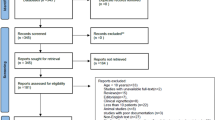Abstract
PURPOSE: Dynamic graciloplasty has been used for intractable fecal incontinence, and good results have been reported. The aim of this study was to assess prospectively the safety and efficacy of dynamic graciloplasty for intractable fecal incontinence in a prospective, multicenter trial. METHODS: A total of 123 adults were treated with dynamic graciloplasty at 20 institutions. Continence was assessed preoperatively and postoperatively by use of 14-day diaries. RESULTS: There was one treatment-related death. One hundred eighty-nine adverse events occurred in 91 patients (74 percent). Forty-nine patients (40 percent) required one or more operations to treat complications. One hundred seventy (90 percent) events were resolved. Sixty-three percent of patients without pre-existing stomas recorded a 50 percent or greater decrease in incontinent events 12 months after dynamic graciloplasty, and an additional 11 percent experienced lesser degrees of improvement. Twenty-six percent were not improved, worsened, or exited. In patients with pre-existing stomas, 33 percent achieved successful outcomes at 12 months. This number increased to 60 percent at 18 months. Seventy-eight percent of patients had increased enema retention time, and mean anal canal pressures improved significantly at 12 months. Significant changes in quality of life were also observed. CONCLUSIONS: Objective improvement can be demonstrated in the majority of patients with end-stage fecal incontinence treated with dynamic graciloplasty. Reduction in incontinence episodes can be correlated with improved quality of life. Adverse events are frequently encountered, but most resolve with treatment.
Similar content being viewed by others
References
Baeten CG, Geerdes BP, Adang EM,et al. Anal dynamic graciloplasty in the treatment of intractable fecal incontinence. N Engl J Med 1995;332:1600–5.
Mander BJ, Williams NS. The electrically stimulated gracilis neo-anal sphincter. Eur J Gastroenterol Hepatol 1997;9:435–41.
Rosen HR, Novi G, Zoch G,et al. Restoration of the anal sphincter function by single stage dynamic graciloplasty with a modified (“split sling”) technique. Am J Surg 1998;175:187–93.
Wong WD, Jensen LL, Bartolo DC, Rothenberger DA. Artificial anal sphincter. Dis Colon Rectum 1996;39:1345–51.
Christiansen J, Sparsø B. Treatment of anal incontinence by an implantable prosthetic anal sphincter. Ann Surg 1992;215:383–6.
Lehur PA, Glemain P, Bruley des Varannes S,et al. Outcome of patients with an implanted artificial anal sphincter for severe faecal incontinence: a single institution report. Int J Colorectal Dis 1998;13:88–92.
Madoff RD, Rosen HR, Baeten CG.et al. Safety and efficacy of dynamic muscle plasty for anal incontinence: lessons from a prospective multicenter trial. Gastroenterology 1999;116:549–56.
Zung WW. A self-rating depression scale. Arch Gen Psychiatry 1965;12:63–70.
Baeten CG, Konsten J, Spaans F.et al. Dynamic graciloplasty for treatment of fecal incontinence. Lancet 1991;338:1163–5.
Cavina E. Outcome of restorative perineal graciloplasty with simultaneous excision of the anus and rectum for cancer: a ten-year experience with 81 patients. Dis Colon Rectum 1996;39:182–90.
Rockwood TH, Church JM, Fleshman JW,et al. Fecal incontinence quality of life scale: quality of life instruments for patients with fecal incontinence. Dis Colon Rectum 2000;43:9–17.
Wexner SD, Gonzalez-Padron A, Rius J,et al. Stimulated gracilis neosphincter operation—initial experience, pitfalls, and complications. Dis Colon Rectum 1996;39:182–90.
Geerdes BP, Heineman E, Konsten J, Soeters PB, Baeten CG. Dynamic graciloplasty: complications and management. Dis Colon Rectum 1996;39:912–7.
Williams NS, Patel J, George BP, Hallan R, Watkins ES. Development of an electrically stimulated neo anal sphincter. Lancet 1991;338:1166–9.
Author information
Authors and Affiliations
Additional information
and the Dynamic Graciloplasty Therapy Study Group: H. Randolph Bailey, M.D. (Houston, Texas), Arne Bakka, M.D. (Oslo, Norway), Paul Belliveau, M.D., C.M. (Montreal, Canada), E. Berg, M.D. (Recklinghausen, Germany), W. Donald Buie, M.D., M.S.C.* (Calgary, Canada), Marcus J. Burnstein, M.D. (Toronto, Canada), John Christiansen, M.D., F.R.S.C. (Copenhagen, Denmark), John A. Coller, M.D. (Boston, Massachusetts), Susan Galandiuk, M.D. (Louisville, Kentucky), Laura J. LaFontaine, B.S.* (Minneapolis, Minnesota), Jochen Lange, M.D. (St. Gallen, Switzerland), Robert D. Madoff, M.D.* (Minneapolis, Minnesota), Klaus E. Matzel, M.D., Ph.D. (Erlangen, Germany), Lars Påhlman, M.D.* (Uppsala, Sweden), Roland Parc, M.D. (Paris, France), John C. Reilly, M.D. (Erie, Pennsylvania), Massimo Seccia, M.D. (Pisa, Italy), Alan G. Thorson, M.D. (Omaha, Nebraska), Anthony M. Vernava, III, M.D. (St. Louis, Missouri), Steven Wexner, M.D. (Ft. Lauderdale, Florida)
Writing Committee member.
Supported by Medtronic Inc., Minneapolis, Minnesota.
Read at The American Society of Colon and Rectal Surgeons' 100th Anniversary and Tripartite Meeting, Washington, D.C., May 1 to 6, 1999. Winner of the New York Society of Colon and Rectal Surgeons' A. W. Martin Marino, Sr. award.
About this article
Cite this article
Baeten, C.G.M.I. Safety and efficacy of dynamic graciloplasty for fecal incontinence. Dis Colon Rectum 43, 743–751 (2000). https://doi.org/10.1007/BF02238008
Issue Date:
DOI: https://doi.org/10.1007/BF02238008




